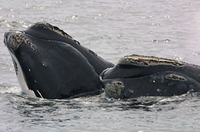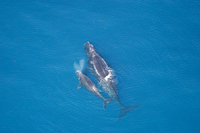Three vessels charged with violating Right Whale ship strike reduction rule pay penalties
Speed restrictions in seasonal management areas reduce risk of death to endangered whales
January 10, 2012

Right whales.
High resolution (Credit: NOAA)
Three large commercial vessels who were assessed civil penalties this fall for violating seasonal speed limits designed to protect one of the most endangered whale species in the world have paid their penalties in full. Cases against six other vessels for the same offense are still open.
The ship strike reduction rule, enacted in December 2008, restricts vessels of 65 feet or greater to speeds of 10 knots or less in seasonal management areas along the East Coast to reduce the chances of North Atlantic right whales being injured or killed by ships.
Notices of Violation and Assessment (NOVAs) were issued Nov. 21 by the NOAA Office of General Counsel’s enforcement section to owners and operators of vessels that allegedly traveled multiple times through the seasonal management areas at speeds well in excess of the 10 knots allowed under the regulations.
The alleged violations occurred between November 2009 and January 2011 outside of New York City; Charleston, S.C.; Brunswick, King’s Bay and Savannah, Ga.; and Mayport, Fla. One vessel was charged with 16 counts of speeding. Vessels’ documented speeds ranged from 13 to 18 knots, and the vessels traveled these speeds for as many as 26 nautical miles.

Right whale and calf.
High resolution (Credit: NOAA)
Each count in the NOVAs was assessed at $5,750, resulting in total penalty assessments ranging from $11,500 to $92,000. None of the vessels receiving NOVAs had prior violations.
The owners and operators had 30 days to respond either by paying the penalty, seeking to have it modified, or requesting a hearing.
Compliance with this rule is critically important for preventing right whale extinction. Ship strikes are the leading source of human-caused mortality for right whales, and together with entanglements in nets, are slowing the recovery of this critically endangered species.
Biologists believe that there are as few as 396 right whales left in the North Atlantic Ocean. Right whales are protected by the Endangered Species Act of 1973 and the Marine Mammal Protection Act of 1972. The death of even one whale can be devastating to the right whale population. NOAA estimates that a female right whale will need to give birth to four healthy calves over her lifetime to successfully replace herself within the population.
The mission of NOAA’s Office of Law Enforcement is to ensure compliance with the laws and regulations enacted to conserve and protect our nation's marine resources. To report a suspected violation, contact Enforcement’s national hotline at 1-800-853-1964.
For more information on the Right Whale Ship Strike Reduction Rule, including a compliance guide with maps of the seasonal management areas and dates they are in effect, visithttp://www.nmfs.noaa.gov/pr/shipstrike/
NOAA’s mission is to understand and predict changes in the Earth's environment, from the depths of the ocean to the surface of the sun, and to conserve and manage our coastal and marine resources. Join us on Facebook, Twitter and our other social media channels.
